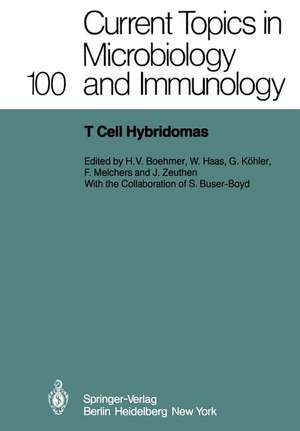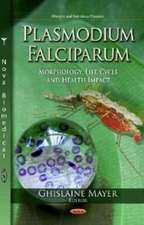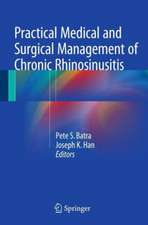T Cell Hybridomas: A Workshop at the Basel Institute for Immunology: Current Topics in Microbiology and Immunology, cartea 100
S. Buser-Boyd Editat de H. v. Boehmer, W. Haas, G. Köhler, F. Melchers, J. Zeuthenen Limba Engleză Paperback – noi 2011
Din seria Current Topics in Microbiology and Immunology
- 18%
 Preț: 962.03 lei
Preț: 962.03 lei - 5%
 Preț: 1123.13 lei
Preț: 1123.13 lei -
 Preț: 499.76 lei
Preț: 499.76 lei - 5%
 Preț: 967.79 lei
Preț: 967.79 lei - 18%
 Preț: 1118.62 lei
Preț: 1118.62 lei - 5%
 Preț: 712.97 lei
Preț: 712.97 lei - 5%
 Preț: 709.51 lei
Preț: 709.51 lei - 5%
 Preț: 709.51 lei
Preț: 709.51 lei - 5%
 Preț: 721.19 lei
Preț: 721.19 lei - 5%
 Preț: 359.78 lei
Preț: 359.78 lei - 5%
 Preț: 711.88 lei
Preț: 711.88 lei - 5%
 Preț: 774.81 lei
Preț: 774.81 lei - 15%
 Preț: 640.06 lei
Preț: 640.06 lei - 5%
 Preț: 717.00 lei
Preț: 717.00 lei - 5%
 Preț: 360.34 lei
Preț: 360.34 lei - 5%
 Preț: 707.69 lei
Preț: 707.69 lei - 5%
 Preț: 717.56 lei
Preț: 717.56 lei - 5%
 Preț: 716.28 lei
Preț: 716.28 lei - 5%
 Preț: 717.20 lei
Preț: 717.20 lei - 5%
 Preț: 711.32 lei
Preț: 711.32 lei - 5%
 Preț: 711.88 lei
Preț: 711.88 lei - 5%
 Preț: 718.29 lei
Preț: 718.29 lei - 5%
 Preț: 709.51 lei
Preț: 709.51 lei - 5%
 Preț: 369.84 lei
Preț: 369.84 lei - 5%
 Preț: 712.25 lei
Preț: 712.25 lei - 5%
 Preț: 716.45 lei
Preț: 716.45 lei - 5%
 Preț: 706.60 lei
Preț: 706.60 lei - 5%
 Preț: 711.52 lei
Preț: 711.52 lei - 5%
 Preț: 713.54 lei
Preț: 713.54 lei - 5%
 Preț: 720.47 lei
Preț: 720.47 lei - 5%
 Preț: 725.42 lei
Preț: 725.42 lei - 5%
 Preț: 708.06 lei
Preț: 708.06 lei - 5%
 Preț: 713.70 lei
Preț: 713.70 lei - 5%
 Preț: 705.83 lei
Preț: 705.83 lei - 5%
 Preț: 710.96 lei
Preț: 710.96 lei - 5%
 Preț: 723.93 lei
Preț: 723.93 lei - 5%
 Preț: 707.69 lei
Preț: 707.69 lei - 5%
 Preț: 715.35 lei
Preț: 715.35 lei - 5%
 Preț: 709.87 lei
Preț: 709.87 lei - 5%
 Preț: 359.05 lei
Preț: 359.05 lei - 5%
 Preț: 374.20 lei
Preț: 374.20 lei - 15%
 Preț: 635.31 lei
Preț: 635.31 lei - 5%
 Preț: 707.86 lei
Preț: 707.86 lei - 5%
 Preț: 721.96 lei
Preț: 721.96 lei - 15%
 Preț: 632.88 lei
Preț: 632.88 lei - 15%
 Preț: 632.05 lei
Preț: 632.05 lei - 15%
 Preț: 642.83 lei
Preț: 642.83 lei - 5%
 Preț: 709.14 lei
Preț: 709.14 lei
Preț: 717.00 lei
Preț vechi: 754.74 lei
-5% Nou
Puncte Express: 1076
Preț estimativ în valută:
137.22€ • 141.75$ • 114.20£
137.22€ • 141.75$ • 114.20£
Carte tipărită la comandă
Livrare economică 25 martie-08 aprilie
Preluare comenzi: 021 569.72.76
Specificații
ISBN-13: 9783642685880
ISBN-10: 3642685889
Pagini: 280
Ilustrații: XII, 264 p.
Dimensiuni: 170 x 244 x 15 mm
Greutate: 0.45 kg
Ediția:Softcover reprint of the original 1st ed. 1982
Editura: Springer Berlin, Heidelberg
Colecția Springer
Seria Current Topics in Microbiology and Immunology
Locul publicării:Berlin, Heidelberg, Germany
ISBN-10: 3642685889
Pagini: 280
Ilustrații: XII, 264 p.
Dimensiuni: 170 x 244 x 15 mm
Greutate: 0.45 kg
Ediția:Softcover reprint of the original 1st ed. 1982
Editura: Springer Berlin, Heidelberg
Colecția Springer
Seria Current Topics in Microbiology and Immunology
Locul publicării:Berlin, Heidelberg, Germany
Public țintă
ResearchCuprins
Lectin-Dependent Cytolytic and Cytolymic T Helper Clones and Hybridomas.- Cytotoxic T Cell Hybridomas: Generation and Characterization.- Definition of Function-Related Isotypic Markers on T Cells.- An Antigen-Specific Suppressor T Cell Factor Controlled by Two Genes in the Immunglobulin Heavy Chain Linkage Group and in the I-J Subregion of the H-2 Complex.- Structural and Functional Studies on Antigen-Specific Suppressor Factors from T Cells and T Cell Hybrids.- Purification and Biochemical Analysis of Antigen-Specific Suppressor Factors Isolated from T-Cell Hybridomas.- Dissection of a Suppressor Cell Cascade.- 4-Hydroxy-3-nitro-phenylacetyl (NP)-Specific T Cell Hybridomas.- Regulation of the IgE Response by IgE Class-Specific Suppressor T Hybridomas.- Establishment of Functional, Antigen-Specific T Cell Lines by RadLV-Induced Transformation of Murine T Lymphocytes.- H-2-Restricted Helper Hybridomas: One Locus or Two Control Dual Specificity?.- T Cell Hybridomas Producing Antigen-Specific Factors Express Heavy-Chain Variable-Region Determinants.- Cytochrome c Specific T Cell Hybrid.- The Effect of Antigen Presentation on the Fine Specificity of Anti-Cytochrome c T Cell Hybridomas.- Analysis of the Anti-Self + TNP Immune Response: T Cell Lines, Clones and Hybridomas.- Functional Characteristics of T Cell Hybridomas Obtained by Fusion of TCGF-Dependent Helper T Cell Clones with BW5147.- A Stable TCGF-Producing T Cell Hybridoma and its Thioguanine-Resistant Variant Suitable as a Tool for the Construction of New Functional T Hybridomas.- Influenza Virus-Specific Murine T Cell Hybridomas Which Recognize Virus Hemagglutinin in Conjunction with H-2d and Display Helper Functions for B Cells.- A “Panreactive” T Cell Line and T Cell Hybridoma: Their Function in Helping B Cells.- A “Panreactive” T Cell Hybridoma Which Produces TCGF Constitutively.- Production of Antigen-Nonspecific Immunoregulatory Lymphokines by T Cell Hybridomas.- Human T Cell Hybridomas with Tetanus-Toxoid-Specific Helper Activity.- Functional Analysis of I1-2 Produced by T-Cell Hybridomas: I1-2 Promotes T-Cell Growth But Does Not Mediate T-Cell or B-Cell Maturation and Differentiation.- Molecular Characterization of Interleukin 2 Produced from Tumor Cell Lines and T Cell Hybridomas.- The Use of T Cell Hybridomas in the Biochemical and Biological Characterization of Multiple Regulatory Factors Produced by T Cells.- Different Factors Active in Lymphoid and Hematopoietic Proliferation Produced by Single Clones of Helper T Cell Hybridomas.- Lymphotoxin and Immune (?) Interferon Production by T Cell Lines and Hybrids.- Antigen Specificity of Continuous T Cell Lines.- List of Contributors.- Indexed in Current Contents.











